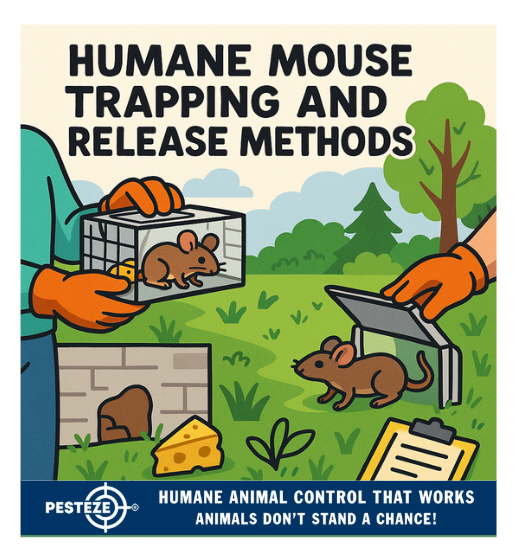HUMANE MOUSE TRAPPING AND RELEASE METHODS

HUMANE MOUSE TRAPPING AND RELEASE METHODS
SUMMARY
This guide explains safe, humane ways to remove mice using live-capture methods, how to release them responsibly, and steps to prevent re-infestation. It emphasizes animal welfare, disease safety, and legal/ethical considerations to protect both people and wildlife.
FEATURES
-
Use Live-Capture Traps: Select small, escape-proof humane traps.
-
Check Traps Frequently: Inspect at least twice daily to minimize stress.
-
Handle with Care: Wear gloves and avoid direct contact when moving traps.
-
Choose Appropriate Release Sites: Release where the mouse can survive and won’t become someone else’s problem.
-
Prevent Re-Entry: Seal entry points and remove attractants to stop future visits.
-
Follow Local Rules & Safety: Check regulations and use disease-safe handling practices.
GUIDE DESCRIPTION
Mice in homes and outbuildings are a common nuisance, but humane management reduces suffering while solving the problem. Live-capture trapping, paired with exclusion and sanitation, is an ethical approach that protects animals and people. Unlike poisons or glue traps, humane live traps allow you to remove mice without inflicting prolonged pain or a slow death. That said, humane removal still requires care: prompt checks, safe handling, and thoughtful release plans.
Begin by choosing the right equipment. Small, purpose-built live-capture traps (single-capture box traps or multiple-capture, ventilated options) work best. Avoid improvised containers that can suffocate or injure animals. Place traps along mouse runways — near baseboards, behind appliances, or by food sources — and bait with attractive food such as peanut butter, oatmeal, or small pieces of fruit. Position traps out of reach of children and pets.
Check traps frequently — ideally morning and evening. Mice trapped for long periods experience stress, dehydration, and vulnerability to predators; frequent checks minimize harm. When you check a trap, wear disposable gloves to reduce disease risk and to avoid transferring human scent that might make other mice wary. If you catch multiple mice, remove and reset traps promptly rather than letting animals share a confined space for long periods.
Handling captured mice requires care. Keep the trap covered with a towel to calm the animal and reduce visual stress. Transport the trap in the upright position to avoid injury. Never release mice inside populated neighborhoods, farms, or protected wildlife areas where they may spread disease, compete with native wildlife, or become agricultural pests. Instead, choose a release site several miles from homes — a wooded edge or field with natural cover and water — but confirm local regulations first; some jurisdictions prohibit relocation of mammalian pests because of ecological and disease concerns.
After removal, focus on prevention. Seal gaps around doors, vents, and foundations with steel wool plus caulk or sheet metal; mice can squeeze through very small openings. Store food in airtight containers, clean crumbs and spilled pet food promptly, and reduce clutter that provides nesting material. Maintain exterior sanitation: secure garbage, remove brush piles, and trim vegetation away from structures.
Finally, follow legal and public-health guidance. Some areas require that certain species not be relocated; trapping and releasing may need permits. Be aware of zoonotic risks—rodent droppings can carry hantavirus and other pathogens—so disinfect trap sites and wash hands after handling. If infestations are large or you suspect disease, contact a licensed pest-control professional or local animal health authorities who can assist with humane and safe solutions.
Humane mouse control is a three-part strategy: catch humanely, release responsibly (where allowed), and prevent return. Doing all three thoughtfully solves the immediate problem while minimizing harm to animals and people.
- Saneeth Thota


Comments 0